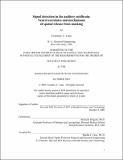Signal detection in the auditory midbrain : neural correlated and mechanisms of spatial release from masking
Author(s)
Lane, Courtney C., 1974-
DownloadFull printable version (1.304Mb)
Other Contributors
Harvard University--MIT Division of Health Sciences and Technology.
Advisor
Bertrand Delgutte.
Terms of use
Metadata
Show full item recordAbstract
Normal-hearing listeners have a remarkable ability to hear in noisy environments, while hearing-impaired listeners and automatic speech-recognition systems often have difficulty in noise. With the ultimate goal of improving hearing aids and speech-recognition systems, we study the neural mechanisms involved in one aspect of noisy-environment listening, "spatial release from masking," which is the observation that a signal is more easily detected when its source is spatially separated from a masking-noise source. We use neurophysiology, computational modeling, and psychoacoustics to investigate the neural mechanisms of spatial release from masking, and we focus on low frequencies, which are important for speech recognition and are often spared in hearing-impaired listeners. Previous studies suggest that at low frequencies, listeners use interaural time differences (ITDs) to improve signal detection when signals and maskers are spatially separated in azimuth. To determine how individual neurons respond to spatially separated signals and maskers, we record in anesthetized cats from low-frequency, ITD-sensitive neurons in the inferior colliculus (IC), a major center of converging auditory pathways in the midbrain. We develop a computational model of the neuron responses, which incorporates both interaural cross-correlation (as used in existing binaural models) and amplitude-modulation sensitivity. The need for modulation sensitivity to predict the neural responses indicates that binaural and temporal processing are interacting in signal detection, rather than acting independently as is often assumed. This modification is especially important because most natural sounds, including speech, have pronounced envelope fluctuations that (cont.) previous models of binaural detection have not utilized. To relate these neurophysiological results to human behavioral thresholds, we define population thresholds based on the most sensitive neurons in the population. The neural population thresholds are similar to human behavioral thresholds, indicating that low-frequency, ITD-sensitive neurons in the IC may be necessary for low-frequency spatial release from masking in humans. Both interaural correlation and modulation sensitivity seem to be required for the model population thresholds to predict human behavioral thresholds. Overall, our findings suggest that considering the auditory system's modulation sensitivity and interaural cross-correlation in the design of hearing aids and speech-recognition systems may improve these devices' performance in noise.
Description
Thesis (Ph. D.)--Harvard-MIT Division of Health Sciences and Technology, February 2004. Includes bibliographical references (p. 138-142). This electronic version was submitted by the student author. The certified thesis is available in the Institute Archives and Special Collections.
Date issued
2004Department
Harvard University--MIT Division of Health Sciences and TechnologyPublisher
Massachusetts Institute of Technology
Keywords
Harvard University--MIT Division of Health Sciences and Technology.